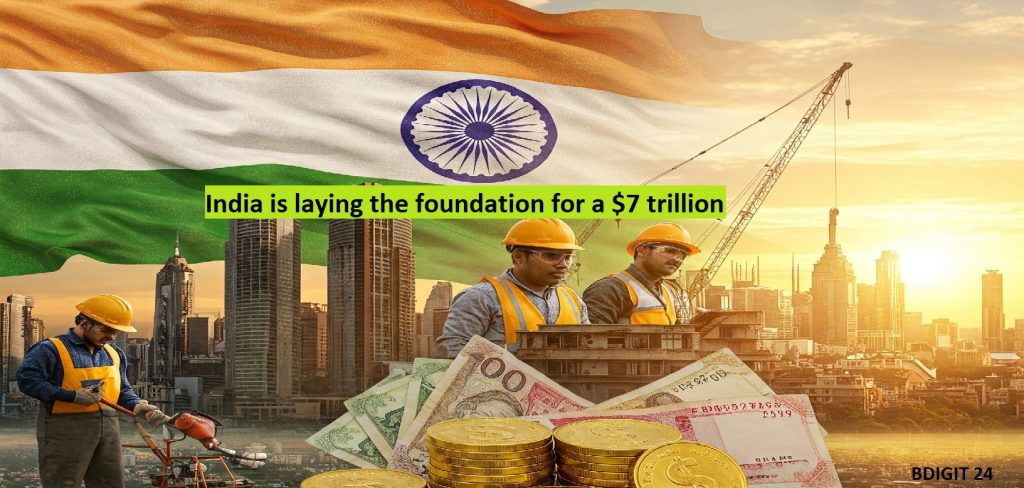With robust infrastructure financing and innovative capital models, India is laying the foundation for a $7 trillion economy by 2030.
India is on an ambitious path to become a $7 trillion economy by 2030, and at the heart of this transformation lies a dynamic and evolving financial system. From infrastructure bonds and sovereign green securities to blended financing and digital credit expansion, India’s financial sector is stepping up to meet the capital demands of a fast-growing economy.
The recent Economic Times CFO Strategy Summit emphasized the need for long-term capital to fund infrastructure projects, which are crucial for sustainable development and inclusive growth. As government budgets alone are insufficient, innovative financing models are becoming essential tools in achieving this vision.
India’s Investment Gap and the $2 Trillion Opportunity
According to estimates, India needs to invest around $2 trillion in infrastructure over the next 7-8 years to meet its economic and urbanization goals. This includes sectors like energy, transportation, digital infrastructure, and urban housing. With 50% of the country’s population expected to live in cities by 2047, the demand for smart infrastructure is skyrocketing.
However, traditional public funding can’t fully bridge this gap. The solution lies in public-private partnerships (PPPs), sovereign and green bonds, and robust financial institutions that can mobilize capital effectively.
Sovereign Green Bonds: A New Era of Responsible Financing
In 2023, India launched its first sovereign green bonds, raising ₹8,000 crore in the inaugural issuance. These bonds are aimed at funding environmentally sustainable projects like clean energy, mass transit, and green buildings.
The global appetite for green investments is growing rapidly. According to Climate Bonds Initiative, the global green bond market crossed $2.5 trillion in cumulative issuance by the end of 2023. India’s entry into this market positions it as a responsible and forward-looking economy.
Financial Innovation: Blended Finance and Infra Funds
Blended finance, which combines public or philanthropic capital with private investment, is gaining traction. For example, the National Infrastructure Investment Fund (NIIF) and India Infrastructure Finance Company Ltd (IIFCL) are attracting institutional investors to co-invest in large projects, mitigating risks and ensuring better returns.
The NIIF has already committed over $6 billion across various sectors, showing how government-backed funds can catalyze private participation.
Additionally, credit enhancements and long-tenure loans from multilateral development banks such as the World Bank and Asian Development Bank (ADB) are helping build investor confidence.
Role of CFOs and Corporate Leaders
In this new environment, the role of Chief Financial Officers (CFOs) and corporate strategists is evolving. CFOs are no longer just number crunchers; they are now key enablers of long-term strategy and ESG (Environmental, Social, and Governance) integration.
CFOs are increasingly turning to data-driven risk management, integrating climate risk analysis into their financial planning, and exploring newer financing avenues like infrastructure investment trusts (InvITs) and real estate investment trusts (REITs).
Digital Finance and MSME Inclusion
India’s digital public infrastructure, such as UPI and Account Aggregator framework, is revolutionizing credit access for small and medium enterprises (MSMEs). These businesses contribute nearly 30% of India’s GDP but often struggle to secure formal financing.
By integrating fintech platforms and real-time credit analytics, MSMEs can now access working capital loans within hours, reducing dependency on informal lenders and increasing their contribution to the formal economy.
Global Capital and India’s Reform-Driven Appeal
Global investors are also taking note of India’s robust macroeconomic fundamentals and reform agenda. According to a report by the Confederation of Indian Industry (CII), India attracted $70 billion in FDI in FY23, with a significant portion directed toward infrastructure and digital services.
Reforms such as the Insolvency and Bankruptcy Code (IBC), GST, and ease of doing business measures have made India an attractive destination for long-term investors.
What Lies Ahead
As India looks ahead to 2030, the financial sector will play a pivotal role in transforming ambitions into actionable projects. Strengthening credit markets, enhancing ESG integration, and expanding access to affordable financing will determine how well India can sustain its growth momentum.
To truly become a $7 trillion economy, India needs to not just mobilize capital, but deploy it smartly, sustainably, and inclusively.
#IndiaGrowthStory #InfrastructureFinancing #GreenBondsIndia #FinancialInnovation #MSMEFinance #EconomicReformsIndia #SustainableDevelopment #CFOLeadership #BDigit24 #BDigit24France #BDigit24Europe #BDigit24India BDigit 24 BDigit 24 Europe BDigit 24 India BDigit 24 France


